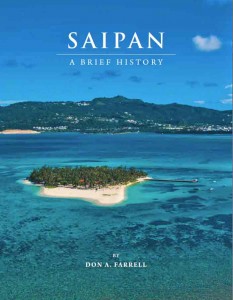Saipan’s rich history in a nutshell
CNMI historian Don Farrell has updated a book he first wrote 26 years ago.
Saipan: A Brief History, which Farrell wrote in 1991, has been updated up to the 20th Legislature, to include new administrations and Chinese and Korean versions of the publication. Its cover shows an aerial photograph of the iconic Managaha Island.
To launch the updated publication, Farrell held a book signing on June 29 at the American Memorial Park museum.
Farrell described his book as the history of Saipan in a nutshell, highlighting the key events of Saipan’s long and in-depth history.
He said he decided to publish a Korean and Chinese version of the book in order for tourists to learn about Saipan’s history.

The cover of Saipan: A Brief History, which Don Farrell first wrote in 1991, shows an aerial photograph of the iconic Managaha Island. (Contributed Photo)
In June’s book signing, a short film was played to showcase the pictures that the book features, starting from the ancient Chamorro era up to photos of Saipan today.
Farrell has also written about the history of Guam. His books have been used in history classes.
Rep. Edwin Propst (Ind-Saipan), who was present at the book signing, said the book is informative, well written, and that he will continue to read it to his children for them to learn more about the island’s rich history.
Saipan: A Brief History is an easy read without scrimping on the important events and details of not only Saipan but the Northern Marianas as well.
It gave a glimpse of how pre-Spanish society on the islands thrived and how the Spanish were so threatened by the natives’ flying proas that they totally outlawed them.
The following German and Japanese colonial periods, according to Farrell, ushered unprecedented economic growth in the islands and gave the indigenous population access to education that was not available during the Spanish era.
World War II was a clash of titans with Saipan an unwitting battlefield for American and Japanese forces, much to the dismay of the island’s local population, according to Farrell.
Post-war life on the Saipan was described by Farrell as a slow and steady journey to self-government as the island, along with Tinian and Rota, inched toward becoming a commonwealth of the U.S., which included an unsuccessful attempt to reunify with Guam.
Farrell also gave a rundown of CNMI governors from Dr. Carlos S. Camacho to Ralph DLG Torres and their respective achievements during their terms.
Farrell’s Saipan: A Brief History is a must-read for history buffs. It can also be a favorite for those who just love to collect coffee table books with its rare photos of pre-World War II Saipan and post-war life on the island.
Not only does the book appeal to islanders, but also it appeals to other ethnic groups that come and want to learn more about the island’s history. Tour guides could also use this book in order to give actual historical facts to tourists.



























